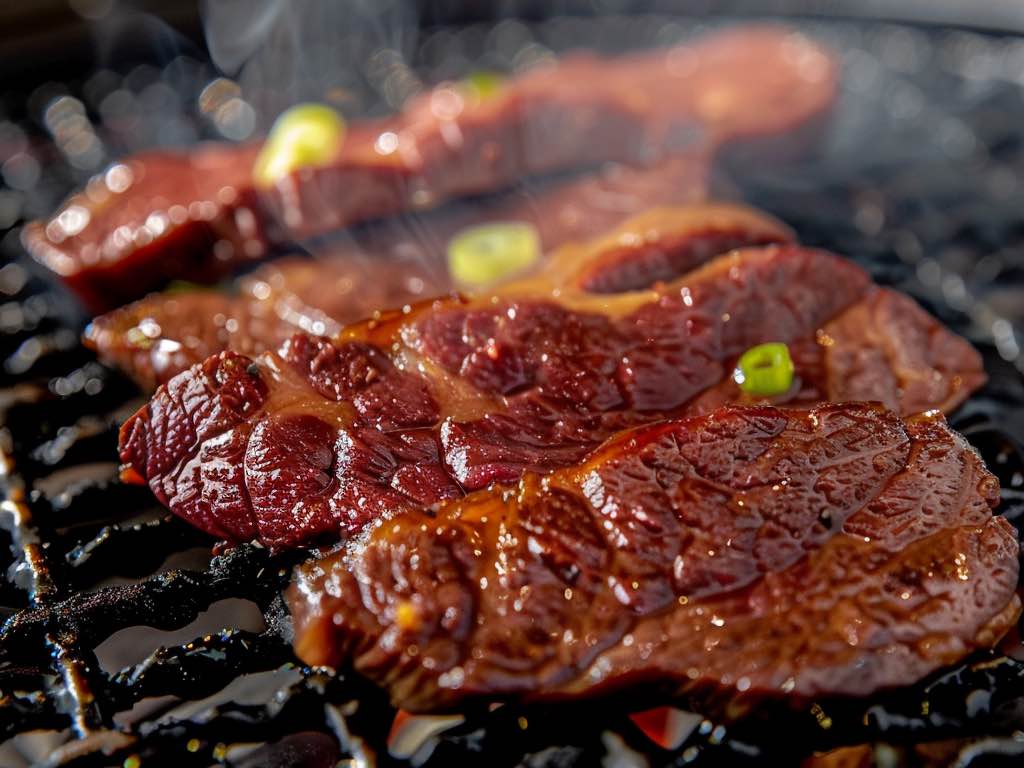
Gyu Tan: The Art and Flavor of Japanese Grilled Beef Tongue
|
|
Time to read 5 min
Welcome to One Stop Halal!
Written by: Samir P.
|
|
Time to read 5 min
Gyu Tan, or grilled ox tongue, is a beloved dish in Japanese cuisine known for its unique texture and rich flavor. Often associated with the city of Sendai, this delicacy has gained popularity across Japan and beyond. In this blog, we will explore the history, preparation methods, and cultural significance of Gyu Tan and share some tips for cooking and enjoying this distinctive dish.
The origin of Gyu Tan as a popular dish can be traced back to post-war Japan. In the 1940s, Keishiro Sano, the owner of a yakitori (grilled chicken) restaurant in Sendai, decided to grill beef tongue as a creative solution to a food shortage. His innovative approach quickly gained popularity, and Sendai became known as the birthplace of Gyu Tan. Today, the dish is enjoyed in restaurants across Japan, with Sendai remaining the most renowned destination for authentic Gyu Tan.
Gyu Tan is celebrated for its unique texture, which is both tender and slightly chewy. The meat's natural fattiness imparts a rich, umami flavor that pairs well with various seasonings and accompaniments. The texture and taste of beef tongue differ significantly from other cuts of beef, making it a standout dish in Japanese cuisine.
In Japanese culinary culture, using every part of the animal is a common practice, and Gyu Tan is an excellent example of this principle. The dish reflects the Japanese ethos of minimal waste and respect for food. It is often served in izakayas and specialty restaurants, making it a popular choice for casual dining and social gatherings.
When selecting beef tongue for Gyu Tan, choosing fresh, high-quality meat is essential. The tongue should be firm to the touch and pinkish in color. Before cooking, the tongue is typically trimmed of excess fat and skin. In some cases, it may be boiled briefly to remove impurities and soften the outer layer.
Marination plays a crucial role in enhancing the flavor of Gyu Tan. A typical marinade includes soy sauce, and garlic. Some recipes also incorporate miso or yuzu (a citrus fruit) for added depth. The tongue is marinated for several hours or overnight to allow the flavors to penetrate the meat.
Grilling is the traditional method of cooking Gyu Tan. The tongue is sliced thinly, usually into pieces about 5-7 millimeters thick, and grilled over a hot charcoal fire. This method imparts the meat a smoky flavor and slightly crispy texture. Grilling the tongue quickly is crucial, as overcooking can make it challenging.
Gyu Tan is often served with a side of rice accompanied by pickled vegetables, such as kimchi or tsukemono (Japanese pickles). It is also common to serve it with a dipping sauce, such as citrusy ponzu or spicy miso sauce. For a traditional Sendai-style meal, Gyu Tan may be accompanied by tail soup and a bowl of barley rice.
Sendai StyleSendai is known for its particular style of preparing Gyu Tan. The tongue is often seasoned with salt or a simple sauce, allowing the meat's natural flavor to shine. The emphasis is on the meat's quality and the chef's skill in grilling it to perfection.Modern TakesIn recent years, chefs have experimented with various preparations and presentations of Gyu Tan. Some modern interpretations include Gyu Tan in curries, stews, or even as a topping for ramen. These variations showcase the versatility of beef tongue and its ability to adapt to different culinary styles.
Opt for fresh, high-quality beef tongue. Look for a firm texture and pinkish color. The tip and middle parts of the tongue are most commonly used for Gyu Tan, offering the best combination of tenderness and flavor.
Grill the tongue slices quickly over high heat, about 1-2 minutes per side. This ensures a crispy exterior and tender interior. Avoid overcooking, as it can make the meat tough.
Serve Gyu Tan with rice and pickled vegetables like kimchi or tsukemono. These sides complement the rich flavor of the tongue and add a refreshing contrast.
While traditional accompaniments like ponzu or spicy miso sauce are popular, experiment with other dipping sauces to find your favorite flavor combination.
Don't limit yourself to the tip and middle parts. Though thicker, the base of the tongue can offer a different texture and flavor profile.
Understanding Gyu Tan's cultural significance enhances the dining experience. It's a dish that reflects the Japanese ethos of using every part of the animal and enjoying simple yet flavorful cuisine.
Welcome to the Home of the Halal Beef. We carry various beef cuts that are hard to find elsewhere. We deliver to your doorstep anywhere in the United States within 1-2 business days.
Gyu Tan is a unique and delicious dish that blends texture, flavor, and cultural richness. Whether you're trying it for the first time or are a seasoned fan, there's always something new to discover in this Japanese delicacy. From its humble beginnings in Sendai to its modern interpretations, Gyu Tan remains a beloved part of Japanese cuisine. So, fire up the grill and enjoy this exquisite dish, savoring the craftsmanship and tradition behind every bite. By exploring the history, preparation methods, and cultural aspects of Gyu Tan, we hope this blog has inspired you to try this unique dish and appreciate its place in the world of Japanese cuisine.

© 2025 One Stop Halal, Inc.